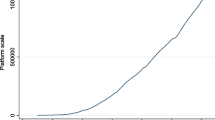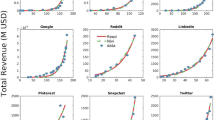Abstract
While social media facilitate product diffusion, the co-existence of competing products makes the diffusion process complex. This study employs an agent-based model to simulate competitive diffusion on social networks and examines the role of a special network position, network bridges, in influencing the diffusion process. The simulation experiments show that targeting bridges can help the weak product with an initially decreasing diffusion curve to increase its market share. The effect of bridges in competitive diffusion increases with the intensity of market competition. This study also reveals that the effect of bridges is larger when the degree distribution of a network has a lower variation. Overall, bridges can be effective alternatives to network hubs in winning market share. Our analysis based on a large-scale real social network further reveals that bridges enhance the offensive and defensive power of a product. This study offers a systematical exploration of the impact of bridges in competitive diffusion under various conditions and the underlying mechanism. It provides guidance for firms competing in social media regarding whom to target (i.e., bridges vs. hubs) and how effective the targeting strategy is.
















Similar content being viewed by others
Notes
For consumers choosing product B in period t, the adoption model is symmetric. That is, the consumer is influenced by information from friends who adopt A/B and his or her choice inertia to continue to adopt product B. She has two states to convert to in period t + 1: being loyal to product B or switching to product A.
As a robustness test, we set three levels of intervention duration. With a long-term strategy, Product W targets bridges and keeps them loyal for 100 periods. With a medium-term strategy, Product W keeps them loyal for 50 periods, and then the selected bridges are free to choose a product afterward. With a short-term strategy, Product W keeps selected bridges loyal for only ten periods, and then they are free to choose a product afterward. Although a longer intervention increases the market share of Product W at the end of diffusion, the conclusion that targeting bridges increases the market share of Product W remains qualitatively unchanged. Our key findings are robust across different duration levels. Therefore, we report only the simulation results of the long-term strategy.
If product A (B) is denoted as Product W, then the bridge node is manipulated to be loyal to product A (B) throughout the diffusion process. The same rule applies to the manipulation of targeting the hub or random node. In practice, if the bridge was not an existing adopter of A (B), acquiring the bridge may incur a cost.
In social networks, betweenness centrality and degree centrality are positively correlated. If we select multiple nodes, say, nodes with the top 10% betweenness or degree centrality as targets, many nodes may belong to both categories. In the network of Fig. 1, three of the top four bridges (75%) are also identified as hubs if we adopt the top 10% rule. A similar proportion of overlapping is also found in real social networks. For example, in the real network in Sect. 5, the correlation between betweenness centrality and degree centrality is 0.72. Therefore, choosing multiple bridges or hubs makes it difficult to determine which node type takes effect. To isolate the cause, we select only one node with a clear hub or bridging role as the target.
The number of consumers for Product W at the end of each simulation t is denoted as \({\mathrm{NO}}_{W\mathrm{hub}}\) and \({\mathrm{NO}}_{W\mathrm{bridge}}\) under the two experimental interventions. The relative strength of targeting the bridge to targeting hub is calculated by \(\left(\frac{{\mathrm{NO}}_{W\mathrm{bridge}}}{{\mathrm{NO}}_{W\mathrm{hub}}}-1\right)*100\%\).
We selected different data periods for analysis. For example, we alternatively chose the period of market saturation as the starting period and chose period 100 or 200 as the ending period. The same analysis procedures were applied. The results remain robust.
We alternatively tagged key bridges as those whose betweenness centrality is one or two standard deviations above the mean. Under these two criteria, we identified 2595 and 1157 nodes as bridges, respectively. Because the results are essentially the same, we report only the results based on the top 4000 bridges.
Influencermarketinghub.com, 8 Influencer Marketing Case Studies with Incredible Results. Online document, https://influencermarketinghub.com/8-influencer-marketing-case-studies-with-incredible-results/. Retrieved on January 10, 2020.
References
Balkundi, P., Kilduff, M., Barsness, Z. I., & Michael, J. H. (2007). Demographic antecedents and performance consequences of structural holes in work teams. Journal of Organizational Behavior: The International Journal of Industrial, Occupational and Organizational Psychology and Behavior, 28(2), 241–260.
Bass, F. M. (2004). Comments on “a new product growth for model consumer durables the bass model.” Management Science, 50(12), 1833–1840.
Baum, D., Spann, M., Füller, J., & Thürridl, C. (2019). The impact of social media campaigns on the success of new product introductions. Journal of Retailing and Consumer Services, 50(9), 289–297.
Bergstrom, C. T., & Bak-Coleman. J. B. (2019). Information gerrymandering in social networks skews collective decision-making. Nature Selected Article 573, 40–41.
Bimpikis, K., Ozdaglar, A., & Yildiz, E. (2016). Competitive targeted advertising over networks. Operations Research, 64(3), 705–720.
Cross, R., & Cummings, J. N. (2004). Tie and network correlates of individual performance in knowledge-intensive work. Academy of management journal, 47(6), 928–937.
Cui, F., Hu, H., Cui, W., & Xie, Y. (2018). Seeding strategies for new product launch: The role of negative word-of-mouth. PLoS ONE, 13(11), 1–23.
Delre, S. A., Jager, W., Bijmolt, T. H., & Janssen, M. A. (2007). Targeting and timing promotional activities: An agent-based model for the takeoff of new products. Journal of Business Research, 60(8), 826–835.
Dodds, P. S., Muhamad, R., & Watts, D. J. (2003). An experimental study of search in global social networks. Science, 301(5634), 827–829.
Dubey, P., R. Garg and B. De Meyer. (2006). Competing for customers in a social network: The quasi-linear case. In International Workshop on Internet and Network Economics (pp. 162–173). Springer.
Dunbar, R. (2010). You' ve Got to Have (150) Friends. http://www.nytimes.com/2010/12/26/opinion/26dunbar.html?mcubz=0. Accessed 01 Jan 2020.
Dutta, A. (2019). Xiaomi's India play runs on social media warriors. Online document, https://www.rediff.com/business/report/xiaomis-india-play-runs-on-social-media-warriors/20190226.htm. Retrieved on January 10, 2020.
Gleeson, J. P., Ward, J. A., O’Sullivan, K. P., & Lee, W. T. (2013). Competition-induced criticality in a model of meme popularity. Physical Review Letters, 112(4), 1–18.
Goldenberg, J., Libai, B., & Muller, E. (2001). Talk of the network: A complex systems look at the underlying process of word-of-mouth. Marketing Letters, 12(3), 211–223.
Goldenberg, J., Han, S., Lehmann, D. R., & Hong, J. W. (2009). The role of hubs in the adoption process. Journal of Marketing, 73(2), 1–13.
González-Bailón, S., & Wang, N. (2016). Networked discontent: The anatomy of protest campaigns in social media. Social Networks, 44(1), 95–104.
Goyal, S., Heidari, H., & Kearns, M. (2014). Competitive contagion in networks. The 46th ACM Symposium on Theory of Computing (pp. 58–79). New York.
Gu, J., Wang, X., & Lu, T. (2019). I like my app but I wanna try yours: Exploring user switching from a learning perspective. Internet Research, 30(2), 611–630.
Hinz, O., Skiera, B., Barrot, C., & Becker, J. U. (2011). Seeding strategies for viral marketing: An empirical comparison. Journal of Marketing, 75(6), 55–71.
Hou, R., Wu, J., & Du, H. S. (2017). Customer social network affects marketing strategy: A simulation analysis based on competitive diffusion model. Physica A: Statistical Mechanics and its Applications, 469(1), 644–653.
Hu, H., Lin, J., Qian, Y., & Sun, J. (2018). Strategies for new product diffusion: Whom and how to target? Journal of Business Research, 83, 111–119.
Jiang, G., Tadikamalla, P. R., Shang, J., & Zhao, L. (2016). Impacts of knowledge on online brand success: An agent-based model for online market share enhancement. European Journal of Operational Research, 248(3), 1093–1103.
Katona, Z., Zubcsek, P. P., & Sarvary, M. (2011). Network effects and personal influences: The diffusion of an online social network. Journal of Marketing Research, 48(3), 425–443.
Kiesling, E., Günther, M., Stummer, C., & Wakolbinger, L. M. (2012). Agent-based simulation of innovation diffusion: A review. Central European Journal of Operations Research, 20(2), 183–230.
Lever, C. R. (2010). Strategic competitions over networks. Ph. D. thesis, Stanford University.
Libai, B., Muller, E., & Peres, R. (2013). Decomposing the value of word-of-mouth seeding programs: Acceleration versus expansion. Journal of Marketing Research, 50(2), 161–176.
Mahajan, V., Muller, E., & Bass, F. M. (1991). New product diffusion models in marketing: A review and directions for research. Diffusion of technologies and social behavior (pp. 125–177). Springer.
Mochalova, A., & Nanopoulos, A. (2013). On the role of centrality in information diffusion in social networks. Proceedings of the 21st European Conference on Information Systems (pp. 101–113). Netherlands.
Negahban, A., & Yilmaz, L. (2014). Agent-based simulation applications in marketing research: An integrated review. Journal of Simulation, 8(2), 129–142.
Newman, M. E., & Park, J. (2003). Why social networks are different from other types of networks. Physical Review E, 68(3), 1–9.
Ramakrishnan, V. (2019). How Netflix’s social media strategy dominates the online streaming industry. Online document, https://blog.unmetric.com/netflix-social-media-strategy. Retrieved on January 10, 2020.
Risselada, H., Verhoef, P. C., & Bijmolt, T. H. (2014). Dynamic effects of social influence and direct marketing on the adoption of high-technology products. Journal of Marketing, 78(2), 52–68.
Statistica. (2018). Social media marketing-Statistics & Facts. https://www.statista.com/topics/1538/social-media-marketing/. Accessed 01 Jan 2020.
Valera, I., Gomez-Rodriguez, M., & Gummadi, K. (2015). Modeling adoption of competing products and conventions in social media. IEEE International Conference on Data Mining (pp. 1–10). Atlantic City, New Jersey, USA, Citeseer.
Viswanath, B., Mislove, A., Cha, M., & Gummadi, K. P. (2009). On the evolution of user interaction in Facebook. Proceedings of the 2nd ACM workshop on Online social networks (pp. 37–42). Barcelona Spain.
Watts, D. J., & Dodds, P. S. (2007). Influentials, networks, and public opinion formation. Journal of Consumer Research, 34(4), 441–458.
Yildiz, E., Ozdaglar, A., Acemoglu, D., Saberi, A., & Scaglione, A. (2013). Binary opinion dynamics with stubborn agents. ACM Transactions on Economics and Computation (TEAC), 1(4), 1–30.
Zhang, H., Fam, K., Goh, T., & Dai, X. (2018). When are influentials equally influenceable? The strength of strong ties in new product adoption. Journal of Business Research, 82, 160–170.
Author information
Authors and Affiliations
Corresponding author
Ethics declarations
Conflict of interests
The authors declare the following financial interests or personal relationships which may be considered as potential competing interests: this work was supported by the National Natural Science Foundation of China (Grant #71531006 and #71702103) and the Program for Professor of Special Appointment (Eastern Scholar) at Shanghai Institutions of Higher Learning.
Additional information
Publisher's Note
Springer Nature remains neutral with regard to jurisdictional claims in published maps and institutional affiliations.
About this article
Cite this article
Gu, J., Xu, Y. Battle of positioning: exploring the role of bridges in competitive diffusion. J Comput Soc Sc 5, 319–350 (2022). https://doi.org/10.1007/s42001-021-00127-7
Received:
Accepted:
Published:
Issue Date:
DOI: https://doi.org/10.1007/s42001-021-00127-7




